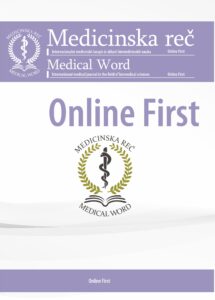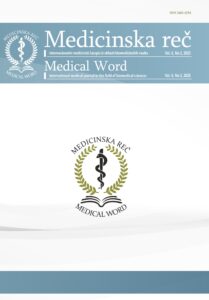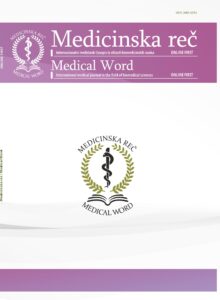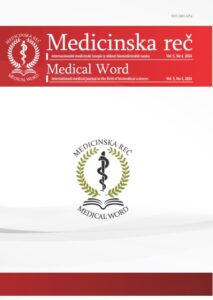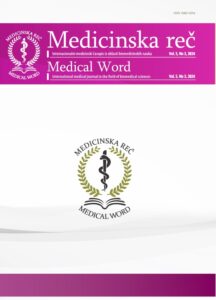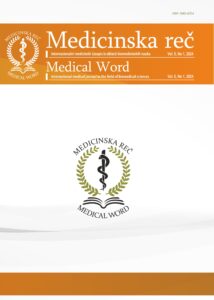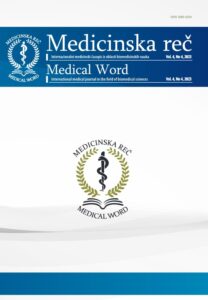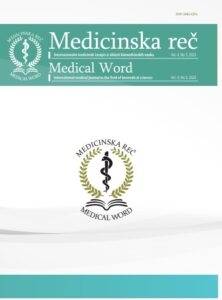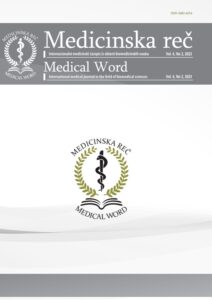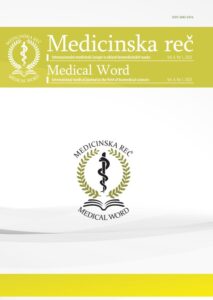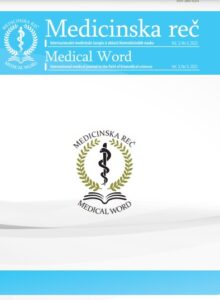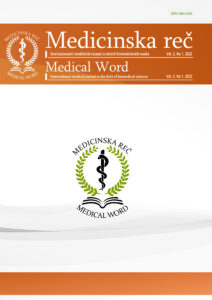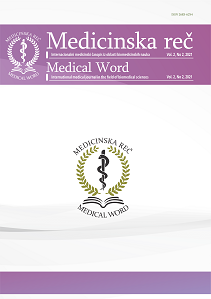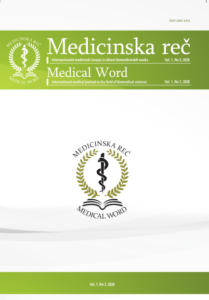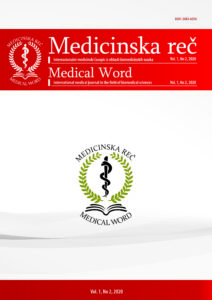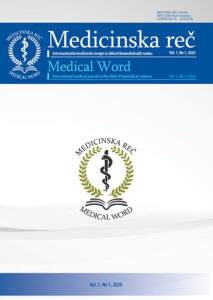Hypertrophic Stenosis of the Pylorus – Single Center Experience
Original article
Nikola Vacić, Ana Kostić, Ivona Đorđević, Nikola Bojović, Žaklina Milošević Anđelković, Andrijana Jovanović
130–133
https://doi.org/10.5937/medrec2404130V
Abstract
This paper aims to show the challenges faced by clinicians when diagnosing hypertrophic pyloric stenosis, the distribution of patients according to gender and age, the variability of the ultrasound dimensions of the pylorus, and the frequency of postoperative complications. Retrospective analysis of electronic medical records, over three years, collected 22 patients with hypertrophic pyloric stenosis who underwent operative treatment – pyloromyotomy. Of 22 subjects, one child was female (4.55%) and 21 (95.45%) were male. The average age of patients of both sexes at admission was 31.2 ± 10.9 days. The youngest recorded case is a 9-day-old male newborn, and the oldest is a 60-day-old male infant. Complaints manifested themselves on average 5.3 ± 3.5 days before admission. On the ultrasound findings of the pylorus, the average length was 19.5 ± 2.3 mm, the average width was 13.4 ± 1.8 mm, and the average thickness of the muscle wall was 4.9 ± 0.6 mm. Postoperative complications were registered in two patients. One developed a fever of up to 40 degrees rectally on the first postoperative day. In the second case, it was a recurrence of hypertrophic pyloric stenosis, which required reintervention.Hypertrophic stenosis of the pylorus remains an enigma in the etiological sense. Usually healthy, full-term children with high Apgar scores become surgical patients soon after birth. Considering that it is one of the few diseases with adequate diagnostic and treatment methods, it is necessary to focus future research on finding the etiological factor that leads to it.
Key words: hypertrophic pyloric stenosis, vomiting, infants, pyloromyotomy
Literatura
- Garfield K, et al. Pyloric Stenosis. [Updated 2023 Jan 30]. In: StatPearls [Internet]. Treasure Island (FL): StatPearls Publishing; 2024 Jan-. https://www.ncbi.nlm.nih.gov/books/NBK555931/
- Murchison L, De Coppi P, Eaton S. Post-natal erythromycin exposure and risk of infantile hypertrophic pyloric stenosis: a systematic review and meta-analysis. Pediatr Surg Int 2016;32(12):1147-52.
- Osifo DO, Evbuomwan I. Does exclusive breastfeeding confer protection against infantile hypertrophic pyloric stenosis? A 30-year experience in Benin City, Nigeria. J Trop Pediatr 2009;55(2):132-4.
- Rogers IM. The Cause of Pyloric Stenosis of Infancy? -A View from the Sidelines. EC Paediatrics 2017;5(2):47-54.
- O Boybeyi, Karnak I, Ekinci S, et al. Late-onset hypertrophic pyloric stenosis: definition of diagnostic criteria and algorithm for the management. J Pediatr Surg 2010;45(9):1777-83.
- Jacobs C, Johnson K, Khan FA, Mustafa MM. Life-threatening electrolyte abnormalities in pyloric stenosis. J Pediatr Surg Case Rep 2019;43:16-8.
- Gibbs MK, Van Herrden JA, Lynn HB. Congenital hypertrophic pyloric stenosis. Surgical experience. Mayo Clin Proc 1975;50(6):312-6.
- Fell D, Chelliah S. Infantile pyloric stenosis. BJA CEPD Rev 2001;1(3):85-8.
- Piotto L, Gent R, Taranath A, Bibbo G, Goh DW. Ultrasound diagnosis of hypertrophic pyloric stenosis – Time to change the criteria. Australas J Ultrasound Med 2022;25(3):116-26.
- Vujović D. Analysis of predictive factors for treatment outcome of hypertrophic pyloric stenosis by using a solution of atropine sulfate [dissertation on the Internet]. Belgrade: University of Belgrade; 2019. Available from: https://phaidrabg.bg.ac.rs/o:20721
- Chandran L, Chitkara M. Vomiting in children: reassurance, red lag, or referral? Pediatr Rev 2008;29(6):183-92.
- Leaphart CL, Borland K, Kane TD, Hackam DJ. Hypertrophic pyloric stenosis in newborns younger than 21 days: remodeling the path of surgical intervention. J Pediatr Surg 2008;43(6):998-1001.
- Spitz L, Batcup G. Haematemesis in infantile hypertrophic pyloric stenosis: the source of the bleeding. Br J Surg 1979;66(11):827-8.
- Piroutek MJ, Brown L, Thorp AW. Bilious vomiting does not rule out infantile hypertrophic pyloric stenosis. Clin Pediatr (Phila) 2012;51(3):214-8.
- Papadakis K, Chen EA, Luks FI, et al. The changing presentation of pyloric stenosis. Am J Emerg Med 1999;17(1):67-9.
- Nmadu PT. Alterations in serum electrolytes in congenital hypertrophic pyloric stenosis: a study in Nigerian children. Ann Trop Paediatr 1992;12(2):169-72.
- Gotley LM, Blanch A, Kimble R, Frawley K, Acworth JP. Pyloric stenosis: a retrospective study of an Australian population. Emerg Med Australas 2009;21(5):407-13.
- Kumar A, Gupta UK, Gupta PS, et al. Study of clinical, biochemical evaluation and outcome in hypertrophic pyloric stenosis. Int J Contemp Pediatr 2016;3(2):473-6.
- Bašković M, Sinjeri D. Diagnostic Accuracy of Acid-Base Status in Infants with Hypertrophic Pyloric Stenosis. Children (Basel) 2022;9(12):1815.
- Khan AA, Yousaf MA, Ashraf M. Role of ultrasonography in early diagnosis of infantile hypertrophic pyloric stenosis. J Ayub Med Coll Abbottabad 2014;26(3):316-9.
- Ein SH, Masiakos PT, Ein A. The ins and outs of pyloromyotomy: What we have learned in 35 years. Pediatr Surg Int 2014;30(5):467-80.
- Kosoko AA, Tobar DC. Recurrent Infantile Hypertrophic Pyloric Stenosis in the Emergency Department: A Case Report. Clin Pract Cases Emerg Med 2022;6(4):284-7.


